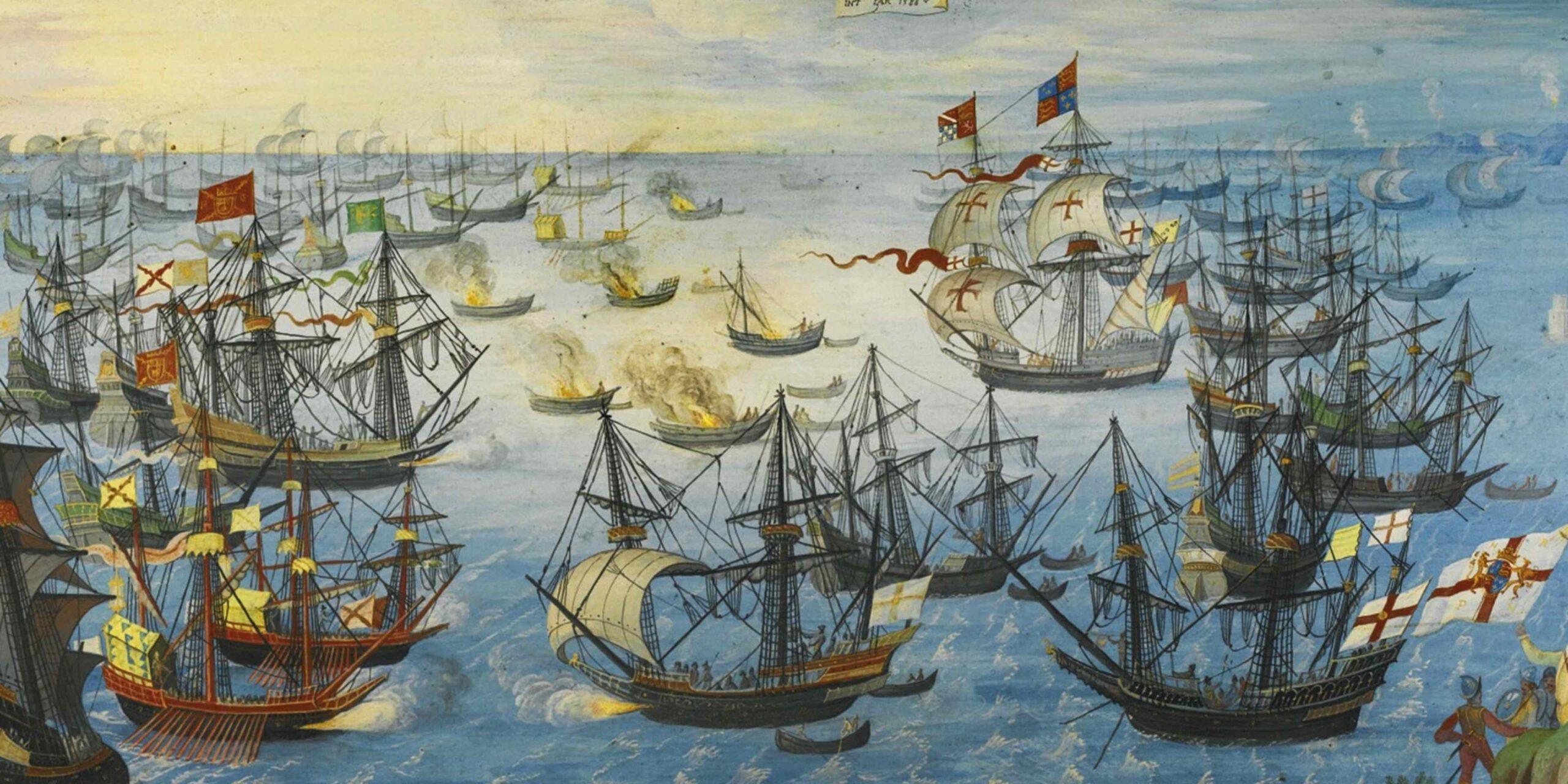
The Spanish Armada and the Defeat of the Greatest Naval Power
The year is 1588. A massive fleet, the Spanish Armada, sails towards England, representing the seemingly insurmountable might of the Spanish Empire. King Philip II of Spain, a devout Catholic, aims to crush the Protestant rebellion in England under Queen Elizabeth I, a move that would dramatically reshape the political and religious landscape of Europe. This ambitious expedition, however, would culminate in a resounding defeat, marking a pivotal moment in naval history and signaling the decline of Spanish dominance and the ascendance of England as a major maritime power. This essay will delve deeply into the events surrounding the Spanish Armada, exploring its context, the strategies employed by both sides, the battle itself, and its lasting legacy on European history.
The Genesis of the Armada: A Storm Brewing in the Atlantic
The Spanish Armada wasn’t a sudden, impulsive act. It was the culmination of decades of simmering tensions between Spain and England. Philip II, the ruler of a vast empire encompassing territories across the Americas, Europe, and Asia, viewed England as a persistent thorn in his side. Elizabeth I’s support for Dutch rebels fighting against Spanish rule in the Netherlands was a major irritant. The Dutch Revolt, a protracted conflict fueled by religious and political dissent, had drained Spanish resources and challenged Philip’s authority. England’s actions weren’t limited to providing support; English privateers, sanctioned or unsanctioned, relentlessly harassed Spanish treasure fleets returning from the Americas, significantly impacting Spain’s wealth and economic stability. These attacks weren’t mere piracy; they were strategic blows aimed at crippling Spain’s financial backbone, a crucial component of its imperial power.
The religious dimension further inflamed the conflict. Philip II, a staunch Catholic, saw Elizabeth I, the head of the Protestant Church of England, as a heretic and a threat to the unity of Christendom. The English Reformation, with its rejection of Papal authority and its embrace of Protestantism, was a constant source of friction. Philip’s ambitions extended beyond the mere suppression of English rebellion. He envisioned a re-Catholicization of England, which he perceived as a necessary step towards restoring religious unity in Europe and consolidating his power. This desire for religious uniformity fueled his aggressive foreign policy and, consequently, the decision to launch the Armada.
The planning and preparation for the Armada were immense undertakings. The sheer scale of the endeavor is staggering. The fleet comprised over 130 ships, carrying an estimated 25,000 to 30,000 men, including soldiers, sailors, and support personnel. This enormous force represented the pinnacle of Spanish naval technology and military organization at the time. The ships themselves were a diverse collection, ranging from large galleons – the powerful warships of the era – to smaller, faster galleys designed for maneuverability in coastal waters. The Armada’s armament was formidable, boasting a vast array of cannons, mortars, and other weaponry, capable of inflicting devastating damage on enemy vessels.
The selection of the commander, Alonso Pérez de Guzmán, the Duke of Medina Sidonia, proved to be a critical decision with far-reaching consequences. While a nobleman of impeccable lineage, Medina Sidonia lacked extensive naval experience, a fact that would prove detrimental to the Armada’s effectiveness. His appointment, arguably a product of courtly politics rather than strategic acumen, foreshadowed some of the challenges the Armada would encounter. The Duke was burdened with managing a vast, complex operation, relying heavily on the advice and guidance of experienced naval officers, some of whom were openly critical of the overall plan.
The Armada’s departure from Lisbon on May 28, 1588, was delayed by several weeks due to adverse weather conditions, a harbinger of the misfortune to come. This initial delay, while seemingly insignificant, allowed the English more time to prepare their defenses and gave rise to a sense of overconfidence within the English ranks.
England’s Response: A David and Goliath Confrontation
Queen Elizabeth I, despite facing a seemingly insurmountable threat, demonstrated remarkable resolve and decisiveness. While England’s navy was significantly smaller than Spain’s, possessing only around 34 ships compared to the Armada’s 130, it possessed certain advantages that would ultimately prove crucial. The English ships, generally faster and more maneuverable than their Spanish counterparts, were better suited to the tactics of the English naval strategy. The smaller size of the English ships provided speed and agility, enabling them to outmaneuver the slower, larger Spanish galleons.
The English navy wasn’t simply a collection of ships; it was a highly skilled and experienced force, comprising both veteran sailors and skilled commanders. Lord Howard of Effingham, the Lord High Admiral, expertly led the English fleet. He was ably supported by renowned figures such as Sir Francis Drake, Sir John Hawkins, and Sir Martin Frobisher – men who had gained extensive experience from years of raiding Spanish shipping in the Americas. The English navy’s strategic and tactical acumen, honed through years of experience in fighting against the Spanish, proved invaluable in the battles to come. These commanders possessed a comprehensive understanding of naval tactics, including the use of fire ships and the skillful exploitation of wind and currents, which played a crucial role in turning the tide against the much larger Spanish fleet.
England’s strategy was not solely focused on direct confrontation; it also involved a calculated approach to disrupting the Armada’s supplies and communication. The English were acutely aware of the vulnerability of a large fleet reliant on external supplies, and they actively sought to intercept and disrupt those supply lines. The English strategy focused on harassment and attrition; they aimed to wear down the Armada through a sustained campaign of smaller engagements, avoiding large-scale confrontations that could have favored the Spanish.
The Battle: A Clash of Titans in the English Channel
The initial skirmishes between the English and Spanish fleets began as the Armada sailed up the English Channel. The English ships, employing their superior speed and maneuverability, repeatedly harassed the slower Spanish galleons, inflicting damage and inflicting casualties, while deftly avoiding decisive large-scale conflicts. The smaller, faster English ships were able to outmaneuver the cumbersome Spanish galleons, attacking them from various angles and exploiting their vulnerabilities. The Spanish tactics, which were more suited to large-scale battles in open water, were less effective in the confined waters of the English Channel.
The most crucial moment of the battle came during the night of July 28-29. The English used a daring tactic, employing eight “fire ships” – vessels laden with combustibles – to attack the Spanish fleet anchored near Calais. The unexpected appearance of these burning ships caused panic and chaos among the Spanish, forcing them to cut their anchor cables and scatter, disrupting their formation and creating an opening for the English to launch a concentrated assault. This bold move forced the Spanish to break their formation, creating opportunities for the English ships to attack.
The next day, the English pursued their advantage, engaging the disorganized Spanish fleet in a series of fierce naval battles. English ships, utilizing their superior speed and agility, relentlessly harassed and attacked the Spanish galleons. The combined effect of the fire ships and the relentless English attacks significantly weakened the Spanish Armada. The Spanish ships suffered heavy casualties and damage, and their morale began to plummet.
The battle raged for several days, with the English pursuing the retreating Spanish fleet. However, the decisive blow was not delivered by the English alone; the weather played a crucial role in the Armada’s ultimate defeat. As the Armada attempted to circumnavigate the British Isles and return to Spain, a severe storm struck, scattering the Spanish ships and wreaking havoc upon them. Many ships were lost to the tempestuous seas, either sinking or being driven aground. This combination of sustained English attacks and the relentless force of nature resulted in the crippling of the Spanish Armada. The once seemingly invincible fleet returned to Spain in a state of disarray, with a significant number of ships lost and many more damaged beyond repair.
The Aftermath: A New World Order
The defeat of the Spanish Armada was a momentous event with profound and long-lasting consequences. It marked the definitive end of Spanish naval supremacy in Europe, shattering the myth of its invincibility. The Spanish Empire, although still powerful, never again possessed the same level of maritime dominance it had enjoyed before 1588. England, on the other hand, emerged as a major naval power, laying the groundwork for its future global expansion and colonial ambitions.
The political and religious ramifications were equally significant. Queen Elizabeth I’s successful defense against the Armada solidified her position as a powerful and effective ruler, bolstering England’s national pride and confidence. The failure of Philip II’s ambitious plans profoundly impacted the religious and political dynamics of Europe. The dream of a unified Catholic Europe, fueled by the Spanish Habsburg dynasty, receded, leaving the continent fractured along religious and political lines.
The Armada’s defeat wasn’t simply a military victory; it was a symbolic triumph, demonstrating that England had arrived as a major force on the global stage. This victory fueled English confidence and laid the groundwork for future maritime and imperial expansion. The defeat of the Spanish Armada was not only a military event but a turning point in European history, marking the transition of maritime dominance from Spain to England.
The Enduring Legacy: A Story Still Told
The legacy of the Spanish Armada continues to resonate in the annals of history. The event continues to be studied and analyzed by historians, serving as a crucial case study in naval warfare, strategic planning, and the interplay between military might, political ambition, and the capriciousness of nature. The battle itself became a subject of numerous historical accounts, artistic representations, and literary works. Its enduring significance is evident in the plethora of historical sites, museums, and memorials dedicated to the events of 1588. The story of the Spanish Armada serves as a compelling reminder of the complexities of historical events and the interplay of factors that can determine the fate of nations. The conflict’s legacy shaped not just the fate of Spain and England, but altered the geopolitical trajectory of Europe and the wider world for centuries to come. The Armada remains a potent symbol of ambition, overreach, and the unpredictable nature of power. Its story is a reminder of how seemingly insurmountable odds can be overcome, and how a combination of skill, strategy, and even a stroke of luck can change the course of history.


